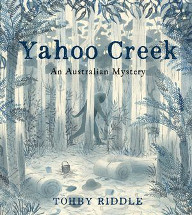Yahoo Creek: an Australian mystery by Tohby Riddle

Allen and Unwin, 2019 ISBN: 9781760631451.
(Age: mid primary) Highly recommended. Themes: Folk tales,
Australian stories, Australian bush, Aboriginal themes, Mystery. A
compilation of numerous newspaper reports of the Yahoo or Hairyman
or Yowie are offered in this unusual picture book from Tohby Riddle.
Each double page is covered in images reflecting the colour of the
Australian bush with a creature visible in the background. Sometimes
it is clutching a tree or moving a log, or staring at a settler, but
most of the time it is strolling through the undergrowth,
unconcerned with the attention it receives.
Edited sections of newspaper accounts from the nineteenth century
are aligned with the images, giving the reader a brief textual
context to compare with each of the stunning illustrations. Readers
will find that they scan the pages looking for clues about this
creature: is it imaginary, is it a real animal, is it human, what
are its features and so on, the mystery which baffles the reader
paralleling the fears of the early Europeans as well as stories told
in the Aboriginal communities.
The predominance of place names with the word Yahoo, intrigues
Riddle, and his acknowledgement of the Aboriginal stories of the
creature, supported with words by Ngiyampaa Elder, Peter Williams,
make this a book in which to immerse readers with the stories of
these mountains running 3,500 kilometres along the east coast of
Australia. Readers will quickly engage with stories about this
animal, comparing it perhaps with other world folk stories
concerning the Yeti, or Bigfoot or Abominable Snowman.
In Boori Pryor's wonderful story of a boy's growing up, My
Girragundji (republished 2018) the boy is fearful of the
hairyman, a creature which lurks in his house at night, and Pryor
links this creature with the Quinkin, an ancient Aboriginal spirit
which causes mischief.
Readers will love musing the layers of meanings and intrigues
offered in this book; Aboriginal culture prior to European
settlement, Europeans and their distrust of the bush (still in
evidence today with lurid tales of death in the bush), reporting of
these sightings in the local newspapers from Geelong to Bega to the
Hunter Valley, showing the spread of white settlement and their
isolation, and even why the Blue Mountains are blue. Riddle's
illustrations born out of many wanderings in the bush reflect the
magnificent variety of fauna and flora that exists in these
mountains. I love his depiction of the increasing encroachment of
Europeans in his illustrations, from a few objets of bedding at the
start, then a camp, and finally a town. The Yahoo can only look on
with slumped shoulders.
This is a fascinating look at a enduring story from Australia's past
sure to rope in those students who love mysteries and pondering
possibilities, and with recent sightings reported and a statue of a
Yowie erected in Queensland, readers may like to look further.
Fran Knight